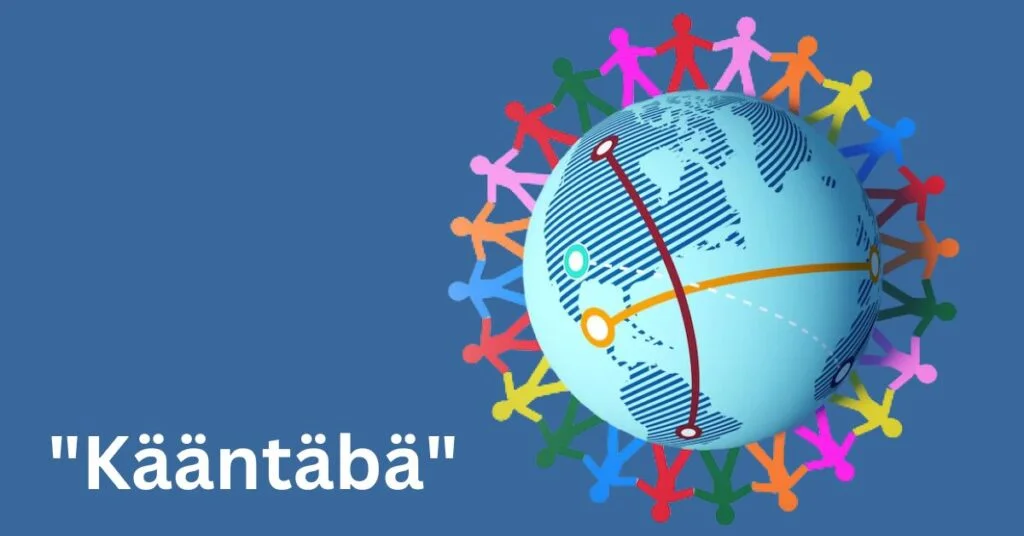Language is a living entity, constantly evolving, borrowing, and adapting to the changing world. Finnish, a unique member of the Uralic language family, presents an intriguing case study of linguistic evolution. One particularly fascinating aspect of Finnish is the verb “kääntää.” This seemingly simple verb, meaning “to turn” or “to translate,” serves as a portal to understanding the complex interplay of linguistics, culture, and history within the Finnish language.
The Origins of “Kääntää”
Historical Linguistics
“Kääntää” traces its origins back to the Proto-Uralic language, the common ancestor of all Uralic languages. The Proto-Uralic language, spoken approximately 7,000 years ago in the region surrounding the Ural Mountains, gradually diversified into several branches, one of which became the Finno-Ugric languages, including Finnish, Estonian, and Hungarian. The verb “kääntää” likely evolved from Proto-Uralic roots that denoted physical turning or twisting, reflecting a fundamental human interaction with the physical world.
Etymological Development
The Finnish word “kääntää” can be etymologically dissected to reveal its historical layers. The root of the verb, “kään-“, is thought to be derived from an ancient Uralic term related to turning or rotating. Over millennia, as Finnish evolved and incorporated influences from neighboring languages and cultures, “kääntää” expanded its meanings to include both physical turning and the abstract concept of translation. This duality in meaning provides insight into the cognitive and cultural shifts that have shaped the Finnish language.
Semantic Evolution
Physical Turning
The primary meaning of “kääntää” is “to turn.” This can refer to the physical act of rotating an object, such as turning a key in a lock or flipping a page in a book. The concept of turning is deeply embedded in human experience, reflecting basic interactions with the physical environment. The Finnish language, with its rich vocabulary for describing physical actions, captures these interactions with precision.
Translation
The secondary, more abstract meaning of “kääntää” is “to translate.” This metaphorical extension from physical turning to linguistic transformation highlights the cognitive process of viewing translation as a form of turning or changing one language into another. This semantic shift mirrors similar developments in other languages, where terms for translation often have roots in physical movement or transformation.
Grammatical Structure
Verb Conjugation
Finnish is an agglutinative language, meaning it forms words and expresses grammatical relationships through the addition of suffixes. The verb “kääntää” is conjugated to indicate tense, mood, person, and number. For instance, the present tense conjugation for the first person singular is “käännän” (I turn/translate), while the past tense is “käänsin” (I turned/translated). This intricate system of suffixes allows for precise expression of temporal and subjective nuances.
Case System
Finnish employs a rich case system, with 15 grammatical cases used to indicate relationships between words in a sentence. When using “kääntää” in different contexts, the choice of case can significantly alter the meaning. For example, “käännän kirjan” (I turn the book) uses the accusative case, while “käännän kirjaa” (I am translating a book) uses the partitive case. This case system adds layers of meaning and specificity to the language.
Cultural Significance
Literature and Translation
Finnish literature has a long tradition of translation, both into and from Finnish. The verb “kääntää” encapsulates this cultural practice, serving as a bridge between languages and cultures. Finnish translators have played a crucial role in bringing global literature to Finnish readers and in introducing Finnish literature to the world. The process of translation is seen as a cultural turning, where texts are transformed and adapted to new contexts.
4National Identity
Language is a key component of national identity, and the Finnish language, with its unique characteristics and history, is a source of pride for Finns. The ability to kääntää, to translate and thus communicate across linguistic boundaries, is seen as a vital skill in maintaining and promoting Finnish culture in a globalized world. This dual meaning of “kääntää” reflects the dynamic interplay between preserving a unique linguistic heritage and engaging with the broader global community.
Comparative Linguistics
Uralic Language Family
Comparing “kääntää” with cognates in other Uralic languages reveals fascinating similarities and differences. For instance, the Hungarian word “fordít” (to turn, to translate) shares a similar semantic duality. Such comparisons highlight the shared linguistic heritage within the Uralic family and the divergent paths taken by these languages over millennia.
Indo-European Influences
Finnish has also been influenced by neighboring Indo-European languages, such as Swedish and Russian. These influences are evident in loanwords and shifts in usage. The concept of translation in Finnish, embodied in “kääntää,” has been shaped by these linguistic interactions, illustrating the porous and adaptive nature of language.
Modern Usage and Adaptation
Technology and New Media
In the digital age, the verb “kääntää” has adapted to new contexts. The proliferation of online translation tools and software has expanded the meaning of “kääntää” to include machine translation. Phrases like “kääntää Googlen avulla” (to translate using Google) are now common, reflecting the integration of technology into everyday language use.
Language Learning and Education
In Finnish language education, the concept of “kääntää” is central to teaching translation skills. Language learners are trained to kääntää texts accurately, reflecting the high value placed on linguistic proficiency and cultural understanding. The process of learning to translate is seen as a key step in mastering the Finnish language and appreciating its nuances.
The Future of “Kääntää”
Linguistic Evolution
As Finnish continues to evolve, the meanings and uses of “kääntää” may further diversify. New technologies, cultural exchanges, and societal changes will shape the verb’s future trajectory. Linguists will continue to study these developments, contributing to a deeper understanding of Finnish and its place in the global linguistic landscape.
Preservation and Innovation
Balancing preservation of linguistic heritage with innovation is a challenge faced by many languages, including Finnish. The verb “kääntää” symbolizes this balance, embodying both the preservation of traditional meanings and the adaptation to new contexts. Efforts to document and study Finnish, alongside initiatives to promote its use in modern media, will ensure that “kääntää” and other aspects of the language remain vibrant and relevant.
Conclusion
The verb “kääntää” offers a rich and multifaceted glimpse into the Finnish language. From its historical roots in the Proto-Uralic language to its modern applications in digital technology, “kääntää” embodies the dynamic and evolving nature of language. By exploring the linguistic, cultural, and historical dimensions of “kääntää,” we gain a deeper appreciation for the complexities of Finnish and the broader human experience of language. Whether turning a key, translating a text, or navigating the intersections of language and culture, “kääntää” stands as a testament to the enduring power of words.







